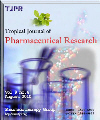
|
Tropical Journal of Pharmaceutical Research
Pharmacotherapy Group, Faculty of Pharmacy, University of Benin, Benin City, Nigeria
ISSN: 1596-5996
EISSN: 1596-5996
Vol. 12, No. 2, 2013, pp. 155-161
|
 Bioline Code: pr13025
Bioline Code: pr13025
Full paper language: English
Document type: Research Article
Document available free of charge
|
|
|
Tropical Journal of Pharmaceutical Research, Vol. 12, No. 2, 2013, pp. 155-161
| en |
Design and Evaluation of Chitosan-Based Novel pH-Sensitive Drug Carrier for Sustained Release of Cefixime
Shivashankar, Murugesh & Mandal, Badal K
Abstract
Purpose: To formulate and evaluate pH-sensitive controlled release cefixime microspheres based on crosslinked chitosan and acryl amide-grafted-poly ethylene glycol
Method: pH sensitive interpenetrating network (IPN) cefixime microspheres based on chitosan, its grafted copolymer, and hydrolyzed grafted copolymer were prepared by precipitation and crosslinking methods. The formulations were characterized by Fourier transform infrared spectroscopy (FTIR),X-ray diffraction(XRD),Differential scanning calorimetry (DSC), Scanning electron microscopy(SEM),Raman spectroscopy for particle size analysis. Swelling ratio, Effect of drug loading on encapsulation efficiency was investigated. FTIR, SEM, DSC, X-ray diffraction XRD, swelling studies were investigated for controlled drug release of drug at pH 2 and pH 74.
Results: The microspheres were spherical in shape with a narrow particle size distribution (56 – 124 µm) and encapsulation efficiency of up to 93 %. The % swelling ratio for blend microspheres of C-PEG are higher than that of plain chitosan in both pH. In both the pH media release was much faster in plain Chitosan microspheres. For instance, only 83% drug was released at 11.5 h for C-grafted copolymer 50 in pH 7.4 media compared to 41% drug released in pH 2 media for the same time whereas 80% drug was released at 11.5 h for C-grafted copolymer 50 (hydrolyzed) in pH 7.4 media compared to 38% drug released in pH 2. Drug release followed Higuchi release kinetics. FTIR, DSC, XRD data indicate that there was no interaction between the drug and the polymers used.
Conclusion: It is evident from this study that chitosan microspheres could be further developed to serve as an effective biodegradable carrier for controlled release of cefixime
Keywords
Chitosan, Polyethylene glycol, Cross-linking, Controlled release, Cefixime
|
| |
© Tropical Journal of Pharmaceutical Research
Alternative site location: http://www.tjpr.org
|
|
